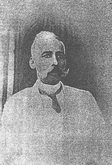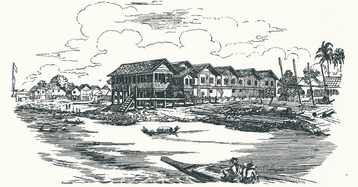Sentry Page Protection
Please Wait...
Biography c. 1928 of
Isaiah Nierses Manook
Isaiah Nierses Manook
|
Isaiah Manook was born in Mandalay on the 11th July 1861 of Armenian-Russian parentage Mr and Mrs N.E. Manook, merchant, trading with King Mindon (1853-1878) and is the maternal grandson of Mr and Mrs Marcar David Abramoff a Russian subject and merchant of Rangoon and Mandalay trading with Kings Shoaybo Min Pagan Min and Mindon Min and the Engshai Min (Crown Prince); the parental grand nephew of Mr Sarkies Manook “Mahabawka-Yahza-thu” and Capt. Joseph Manook; parental grandson of Mr and Mrs Esaiah Manook, Armenians (Turkish subjects) and merchants of Mandalay, Rangoon and Calcutta (1795 to 1848) personal friends of the British Commander-in –Chief Genl. Sir Archibald Campbell and staff of the Army during the British-Burma war of 1824-26, having rendered valuable services to the British; vide the General’s despatches to the Government Political Dept. and Col. Syme’s account of the mission of Mr Crawfurd , British Embassy, to the Court of Ava; paternal nephew of J.S. Manook, Kalawoon, (Foreign Minister) at the Court of King Mindon and of the Embassy (1858-59) and to the Court of Emperor Napoleon III; and the baptismal godson of the late Sir Edward Bose Sladen, British Resident at Mandalay during King Mindon’s reign and British Political Officer during the British-Burma war of 1885.
When he was 40 days old, by order of the Crown Prince, Mr Manook was presented by his parents to King Mindon Min and the Chief Queen, the former naming him “Thone Ban Hla (thrice beautiful flower) and to the Crown Prince and Princess and continued attending the Palace daily with his parents who were in high favour with the Royals. In 1870 he was sent to La Martiniere College, Calcutta where he distinguished himself in class and playground, being a good cricketer, a well-known rugby-footballer, the Captain of the College team and a keen volunteer. In January 1881 aged 19 years he left the College and returned to Rangoon and at the instance of William Greaves, senior partner of the firm Bulloch Bros. Rangoon and J.B. Russell, the firm’s Engineer-in-Chief took service as the company’s assistant Store-keeper at their Lower Pazundaung Mill. On hearing of the cruelties perpetrated by King Thibaw and Queen Supayahlet in the Royal family and of the ill-treatment to which his relatives had been subjected on the pretext of being British spies, he went on ten days leave in September 1883 and clandestinely visited the Myingoon Prince (son of King Mindon Min) a refugee in India and on the 1st January 1884 resigned his appointment and launched on a daring adventure in that he contrived and successfully engineered the escape of the Myingoon Prince at Chunar, Benares and subsequently at Chandernagore (French possession) by concealing him in a large American dealwood trunk with two holes on the side and conveying it by night in a native boat by the river route to Calcutta and then on foot disguised as a Nepalese Cooly to the French Mail boat the S.S. “Tibre” commanded by Capt. Lugan of Messrs. Messageries Maritimes Company which was anchored at the Garden Reach wharf and bound for Madras, Pondicherry and Colombo for transfer to the Company’s S.S. “Neiman” bound for Saigon, thence by land to Lua-Phrabang there to cross the Me Kong river to the opposite town of Lakow, independent Shan State, the Sawbwas of Monai Theince (Henswi) Kengtung, Louksouk and others including the powerful Kareen Chiefs of Kyet-pho-gyi and Kyet-Pho-galay awaited him with open arms to receive him and dethrone King Thibaw and place him on the throne of, now called, Upper Burma while some of King Thibaw’s officials, the Kinwoon Minghe (Prime-Minister) wavering, the major portion of the populace in Upper Burma and no less in Lower (British) Burma, women of Upper Burma, including Princesses, and wives of officials not excepted, were ready to join in the general attack on Mandalay, the Myingoon Prince being long sought for and expected by the people as the only Burmese Prince of great character, with 20 years knowledge of the Western and Indian method of Government, who was likely to govern the country well. The arrival of the Myingoon Prince, accompanied by Mr Manook, at Pondicherry, wherefrom he appealed to Lord Ripon, Viceroy of India to consider his claim to the Throne of Burma and who replied that if the Myingoon Prince surrendered himself to the British Govt. his application would be considered; and subsequently at Saigon hastened King Thibaw to enter into a treaty with the French Government, which if ratified, would have been a great blow to the British interest. However, the timely interview of the British Ambassador at Paris, Lord Lyons, with the French Foreign Minister, Monsieur Jules Ferry and the aggravation of King Thibaw, by inflicting a fine of Rs. 15,00,000 (Rs. 15 Lacs) unwarrantedly on the Bombay Burma Trading Co. were the last nails in the coffin of King Thibaw’s schemes, injustice, cruelties and the Burmese Kingdom and resulted in the advance of the British Army in October 1885, the capture of Mandalay in November 1885, the dethronement of King Thibaw and Queen Supayahlat and the annexation of Upper Burma in the first half of 1886. In June 1885, Mr Manook returned to Rangoon and joined, as an assistant, the firm of Alfred Liebert & Co. Import and Export merchants but resigned in 1894 on being selected by the then Financial Commissioner D.M. Smeaton and appointed on the 14th March 1894 as an expert appraiser in the Rangoon Customs. Experience gained during his mercantile and foreign services stood him in good stead and his promotions were in consequence rapid comparatively, being a marked man by the various Chief Collectors of Customs. In 1900 when Lord and Lady Curzon visited, the latter expressing a desire to purchase large rubies for a tiara and necklace to be worn at the famous Delhi Durbar, Mr Tilly the Chief Collector of Customs, selected Mr Manook and deputed him in search of and to purchase these rubies which he did completing the collection, 17 in number, within a year and a half and earned the thanks of their Excellencies through Mr Tilly. In addition to his duties Mr Manook was deputed in 1907 by the Chief Collector of Customs Mr A.S. Judge, to take charge of the Customs Laboratory and the testing of liquors and alcoholic preparations by the distillation process for assessment to customs duty , the state of affairs prior thereto being far from satisfactory. He not only refitted the laboratory with appliances such as were used in London but by his introduction of Dr. Thorp’s Crystal Stills and Dr. Allan’s method of test, was able to ascertain the real strength of alcohol in liquors and alcoholic preparations with the result that the correct amount of duty was levied, the Financial Commissioner on the recommendations of the Chief Collector, granting an honorarium for Mr Manook. Customs, Police and Excise Officers were trained by him and appointments as Resident Excise Officers were given to the Police and Excise Officers on his certificate of their efficiency in testing liquors. During the Great War (WWI) Mr Manook’s abilities and endurance were tested almost to breaking point, in that in addition to his onerous duties as Chief Appraiser of Customs he was selected by the Chief Collector of Customs J.A. Stevens, at the instance of J.B. Hardiman, Controller of Materials for munitions, to test, receive be responsible for and ship the materials to Military Depots and render accounts, while a good many of his Officers were deputed on special duties elsewhere, the departmental work was falling on him in particular and the few left in the Appraisal Dept. In additional to these duties he was required to scrutinize the Consul’s certificates, covering importations of goods from neutral countries in Europe and Asia and through neutral colonies in the East and near East and to determine whether or not the goods were of enemy production; likewise in the case of goods without invoices and not covered by British Consul’s certificates and to render accounts weekly for the information of the Government. Here his knowledge of the different methods of manufacture of the different countries gained during his commercial life was of great help to him. He stood the test well, in spite of his long working hours. After 25 years of meritorious service, including three years extension of service Mr Manook retired from Government service on the 11th July 1919, having joined at the age of 33 years, contrary to the rule of admittance. He was held in high esteem by the various Chief Collectors of Customs under whom he served and earned the affection and respect of his subordinates and the entire staff and was well known in commercial circles. He took a prominent part in the Armenian War Refugee Relief Work of which he was the Hony. Treasurer, his collection on the whole being much ahead of others. Similarly was the case when Bishop Thorgom of Cairo, with the approval and sanction of the Government, visited the East, including Burma, collecting funds for Refugees Relief Work, His Lordship eulogising Mr Manook’s work and continued so on his homeward journey and in his pamphlets. From 1909 to 1919 Mr Manook was the Warden of the Armenian Church, Rangoon, earning the impartial thanks of the community at the general meeting held in 1919, on his retirement, the remarkable feature during his Wardenship being the entire husbanding of its finances, resulting in a large nett cash balance to the credit of the Church. In 1918 he became a member of the Society for the Promotion of Infant Welfare, Rangoon and a Committee member in 1919 and at the request of the Committee members he took up the roll as Hony. Secretary of the Society and within a very short space of time he not only brought order out of chaos but induced many to subscribe and donate and enforced strict discipline among the nurses and midwives of the Society, who felt it much when he resigned as Secretary owing to ill-health. Lady Craddock, the President, at the last annual meeting held at Government House a few months prior to her final departure in 1922 impartially admitted in her annual report that Mr Manook had taken a great deal of trouble and interest in Infant Welfare. In July 1923, Mr Manook had a serious illness from which he was not expected to recover, however, he did and lives to this day a member of the oldest family in Burma which has been in constant association with its Kings, its Royal Family and British Officials as far back as the first British-Burma war. On the return to Rangoon from Ratnagiri of the late Ex-Queen Supayahlat with her family, Mr Manook, at her request, they having known each other from the days of their youth in the Palace, busied himself in helping her and her family in their public and private affairs till her death on the 24th November 1925 and burial on 17th December 1925, when he was of help to the various Commissioners of Police. In February 1926, Mr Manook was unanimously selected by the Local Government as one admirably suited to act as liaison officer between the Ex-Royal family and the Local Government and be in charge of the family, which post he held since the 1st March 1926, much to the joy of the entire family and undoubtedly to the satisfaction of the local authorities with whom it rests to record aught or otherwise of his work. Mr Manook is a combination of Conservative, Liberal Democrat and Socialist and one always contented whatever his lot, a man without an enemy. Address:- 12A Lancaster Road, Rangoon. |
Residence of G.S. Manook, Rangoon, 1846
from "A History of Rangoon" by B.R. Pearn
from "A History of Rangoon" by B.R. Pearn


